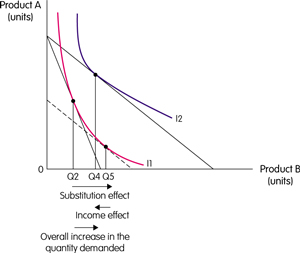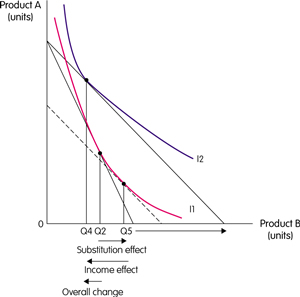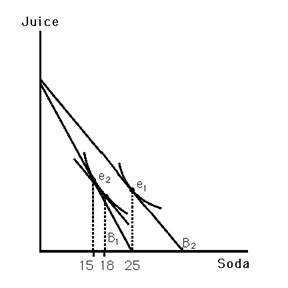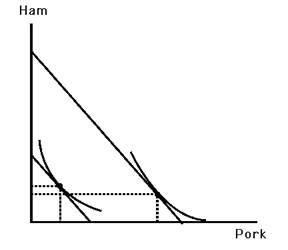- CFA Exams
- 2023 Level I > Topic 2. Economics > Reading 8. Topics in Demand and Supply Analysis
- 3. Substitution Effect, Income Effect, Normal and Inferior Goods
Why should I choose AnalystNotes?
AnalystNotes specializes in helping candidates pass. Period.
Subject 3. Substitution Effect, Income Effect, Normal and Inferior Goods
- As the price of a product declines, the lower opportunity cost will induce consumers to buy more of it since it becomes less expensive - even if they have to give up other products. This is called the substitution effect.
To isolate this effect diagrammatically, we move the new budget line inwards and parallel until it is tangent to the old indifference curve. The new slope reflects the new relative prices but the utility is the same as it was originally. The substitution effect is Q2Q6. The substitution effect will always lead to more of the relatively cheaper product being demanded. - With a fixed amount of money income, a reduction in the price of a product will increase a consumer's real income - the amount of goods and services consumers are able to purchase. Typically, consumers will respond by purchasing more of the cheaper products (as well as other products). This is called the income effect. The income effect is identified by shifting the budget line back outwards again. In this case, this leads to an increase in the quantity demanded of Q6 Q4.
The substitution and income effects will generally work in the same direction, causing consumers to purchase more as the price falls and less as the price rises. The indifference curve can be used to separate these two effects.
In the case of a normal good, higher real income leads to an increase in quantity demanded; this complements the increase due to the substitution effect. This change is shown in the diagram below.

In the case of an inferior product, the income effect leads to a fall in the quantity demanded, which will work against the substitution effect. In the following diagram the substitution effect is Q2 Q5; the income effect is Q5 Q4. However, the substitution effect outweighs the income effect and overall the quantity demanded rises. The overall change in quantity demanded results in an increase of Q2 Q4. This means the demand curve is downward-sloping, because a price fall increases the quantity demanded.

When a good is inferior and the income effect outweighs the substitution effect, it is called a Giffen good. This is, however, unlikely, because the substitution effect is almost always stronger than the income effect.



Another exception is the case where an increase in price causes an increase in demand. This results in an upward-sloping demand curve, and the good is called a Veblen good.
One possible justification for a Veblen good is that people associate higher prices with status, luxury, and quality, so that a higher price might increase the perceived value of a good.
Practice Question 1
The income elasticity of demand for an inferior good is ______.A. equal to zero
B. less than zero
C. greater than zeroCorrect Answer: B
Practice Question 2
For inferior goods, income elasticity is ______.A. greater than 0
B. greater than 1
C. less than 0 Correct Answer: C
Definition of inferior goods: A good that has a negative income elasticity; as consumer income rises, the demand for that good falls.
Practice Question 3
Which one is inconsistent with the fundamental axioms of demand theory?A. An inferior good
B. A Giffen good
C. A Veblen goodCorrect Answer: C
A Veblen good is a good that people buy because it is expensive, as a show of wealth. Therefore it is a superior good with respect to income, but if the price falls, less of the good will be demanded.
Practice Question 4
A Giffen good is always a(n) ______.A. normal good
B. inferior good
C. Veblen goodCorrect Answer: B
The classic example of a Giffen good is bread for the very poor. If their income falls, they will stop buying luxuries such as meat, and will buy more bread instead, to fill themselves up. The demand for bread falls because people have less money to spend on it (the income effect), but it also rises because people use bread as a substitute for meat (the substitution effect). In this case, the substitution effect is larger than the income effect.
Practice Question 5
When income increases, the demand for a good drops. This good is therefore ______.A. an inferior good but not a Giffen good
B. a Giffen good which also an inferior good
C. a Veblen goodCorrect Answer: A
In order to be a true Giffen good, price must be the only thing that changes to get a change in demand.
Practice Question 6
Assume both chicken and beef are normal goods. If the price of chicken rises and the price of beef doesn't rise, consumers will respond by ______.A. substituting beef for chicken
B. substituting chicken for beef
C. reducing purchases of beef and chickenCorrect Answer: B
If the price of chicken has risen but the price of beef has not, the quantity of chicken demanded will fall as consumers substitute chicken for beef.
Practice Question 7
Suppose that an increase in the price of good Y results in an increase in the consumption of good X. This is an example of the ______.A. demand effect
B. substitution effect
C. income effectCorrect Answer: B
The substitution effect is the change in consumption resulting from a change in the relative price of a good.
Practice Question 8
When the price of one of the products that you buy increases, your purchasing power decreases. Thus you are likely to buy less of all normal goods. This is known as the ______.A. demand effect
B. substitution effect
C. income effectCorrect Answer: C
An increase in price reduces your real income, and thus you will tend to buy less of all normal goods. This is the income effect.
Practice Question 9
In the case of a Giffen good with a decrease in its own price, which of the following statements is most likely true?A. Both the substitution and income effects lead to an increase in the quantity purchased.
B. The substitution effect leads to an increase in the quantity purchased while the income effect leads to a decrease.
C. The income effect leads to an increase in the quantity purchased while the substitution effect leads to a decrease.Correct Answer: B
The income effect overwhelms the substitution effect, leading to an overall effect of decreased quantity purchased.
Practice Question 10
Suppose that the interest rate paid to savers increases. As a result, Tom wishes to save more. This suggests that, for Tom, ______A. the substitution effect is greater than the income effect.
B. the income effect is greater than the substitution effect.
C. future consumption is a luxury.Correct Answer: A
Practice Question 11
Median household income is $50,000 per year. The typical household spends about $125 per year on milk, which has an income elasticity of about 0.07. From this information, we can conclude that ______A. milk is a Giffen good.
B. there is no substitution effect for milk.
C. the income effect from a change in the price of milk is very small.Correct Answer: C
Practice Question 12
This figure shows Bobby's indifference map for juice and snacks. Also shown are three budget lines resulting from different prices for snacks assuming he has $20 to spend on these goods. Which of the following points are on Bobby's demand curve for snacks?

A. p = 2, q = 10
B. p = 2, q = 5
C. p = 1, q = 20Correct Answer: B
When their price is $2, he can buy 10 snacks. However, buying 5 snacks and 10 bottles of juice will yield a higher indifference curve.
Practice Question 13
The demand function for good X is Qx = 79 - 22 x Px - 5 x I. X is most likely to be a ______.A. normal good
B. Veblen good
C. Giffen goodCorrect Answer: C
The -22 indicates the higher its own price, the less it is consumed. It is not a Veblen good. The -5 indicates the higher the income, the less the good is consumed. Therefore, it is a Giffen good.
Practice Question 14
Which graph in the following figure best represents a good that is an inferior good at some income levels and a normal good at other income levels?

A. A
B. B
C. C
D. DCorrect Answer: A
Practice Question 15
When John was in college and his income was low, he drank "Red Ribbon" beer. As his income increased, he purchased better-quality beer and less "Red Ribbon." Which graph in the following figure best represents John's Engel curve for "Red Ribbon" beer?

A. A
B. B
C. C
D. DCorrect Answer: D
Practice Question 16
A decrease in income should ______A. shift demand for an inferior product inwards.
B. shift demand for an inferior product outwards.
C. shift supply for an inferior product outwards.Correct Answer: B
Remember consumers will buy less of an inferior good when they have more income as they switch to more luxurious products.
Practice Question 17
If a product is an inferior good, ______A. demand is inversely related to income.
B. demand is inversely related to price.
C. demand is directly related to price.Correct Answer: A
With inferior goods, less is bought when income increases.
Practice Question 18
Average income increases from $20,000 p.a. to $22,000 p.a. Quantity demanded per year increases from 5000 to 6000 units. Which of the following is correct?A. Demand is price inelastic.
B. Income elasticity is -2.
C. The product is normal.Correct Answer: C
The percentage change in demand is +20%; the percentage change in income is +10%. This means the product is normal, because demand rises with more income and has an income elasticity of +2.
Practice Question 19
For an inferior good, ______A. the price elasticity of demand is negative; the income elasticity of demand is negative.
B. the price elasticity of demand is positive; the income elasticity of demand is negative.
C. the price elasticity of demand is negative; the income elasticity of demand is positive.Correct Answer: A
For an inferior good, demand falls as income increases; the quantity demanded falls as price increases. This means the income elasticity and the price elasticity will both be negative.
Practice Question 20
For a normal good, ______A. the price elasticity of demand is negative; the income elasticity of demand is negative.
B. the price elasticity of demand is positive; the income elasticity of demand is negative.
C. the price elasticity of demand is negative; the income elasticity of demand is positive.Correct Answer: C
For a normal good, demand increases as income increases and the quantity demanded falls as price increases.
Practice Question 21
If a product is a Veblen good, ______A. demand is inversely related to income.
B. demand is inversely related to the price of substitutes.
C. demand is directly related to price.Correct Answer: C
Remember, Veblen goods are products of conspicuous consumption. Demand is upward-sloping.
Practice Question 22
An increase in price of a(n) ______ leads to an increase in the quantity purchased at each price.A. Veblen good
B. Giffen good
C. inferior goodCorrect Answer: A
The opposite is true for Giffen goods and inferior goods. Note that Giffen goods are inferior goods.
Practice Question 23
Which one is an inferior good?A. A Veblen good
B. A Giffen good
C. Neither of themCorrect Answer: B
Veblen goods are not inferior goods. The two are fundamentally different.
Practice Question 24
In the case of an inferior good with a decrease in its own price, which of the following statements is most likely true?A. Both the substitution and income effects lead to an increase in the quantity purchased.
B. The substitution effect leads to an increase in the quantity purchased while the income effect leads to a decrease.
C. The income effect leads to an increase in the quantity purchased while the substitution effect leads to a decrease.Correct Answer: B
The substitution effect overwhelms the income effect, leading to an overall effect of increased quantity purchased.
Practice Question 25
The following figure shows Bobby's indifference map for soda and juice. B1 indicates his original budget line. B2 indicates his budget line resulting from a decrease in the price of soda. What change in quantity best represents his income effect?

A. 3
B. 7
C. 10Correct Answer: B
25 - 18 = 7
Practice Question 26
The following figure shows Bobby's indifference map for soda and juice. B1 indicates his original budget line. B2 indicates his budget line resulting from a decrease in the price of soda. What change in quantity best represents his substitution effect?

A. 3
B. 7
C. 10Correct Answer: A
18 - 15 = 3
Practice Question 27
If a good is an inferior good, then ______A. its demand curve will be upward-sloping.
B. its income effect reinforces the substitution effect.
C. its income elasticity is negative.Correct Answer: C
As income goes up, the consumption of an inferior good will actually decrease.
Practice Question 28
One characteristic of a Giffen good is that ______A. it is a luxury good.
B. it is an inferior good.
C. it has an upward-sloping demand curve.Correct Answer: B
All Giffen goods must be inferior, but not all inferior goods are Giffen goods.
Practice Question 29
Even though Mary's income is very low, she makes sure that she purchases enough milk for her family to drink. As her income rises, she buys more milk. Which graph best represents Mary's Engel curve for milk?

A. B
B. C
C. DCorrect Answer: B
Note that C indicates that even if her income is very low (zero) she still buys "enough" milk.
Practice Question 30
The following figure shows Larry's indifference map and budget lines for ham and pork. Which of the following statements is TRUE?

A. Pork is an inferior good.
B. Ham is an inferior good.
C. Neither pork nor ham is an inferior good.Correct Answer: B
As income grows, the consumption of ham actually drops.
Practice Question 31
For inferior goods, a rise in income would result in a(n) ______ and ______ shift in the entire demand curve.A. downward; leftward
B. upward; rightward
C. downward; rightwardCorrect Answer: A
For normal goods, however, a rise in income would shift the entire demand curve upward and to the right.

Study notes from a previous year's CFA exam:
3. Substitution Effect, Income Effect, Normal and Inferior Goods